Many people forget that in 2017 Exit: The Game was not only nominated for the Kennerspiel des Jahres prize, but it also won, beating out the highly ranked Terraforming Mars. Since then Inka and Markus Brand have released new Exit scenarios each year in their native German, English, and 12 other languages. So what is it about Exit: The Game that makes it worthy of the Kennerspiel title? Let’s first take a look at how the game works and then I’ll give you my thoughts on why I love this system so much.

What is Exit: The Game?
Exit: The Game is an escape room game in a box. Everything you will need for the experience is included under the shrink-wrap. I choose to leave my Exit games all bundled up in plastic until I’m ready to play since everything that’s included within could be important for gameplay and the puzzles (…and I really mean everything). It’s also recommended to have the following handy: writing tools (pens, pencils, erasers, and paper), scissors, and something to track time (like the app) since this will determine your final star score.

Each Exit scenario is a standalone experience and they don’t necessarily need to be played in any specific order (although I have recommendations below of which Exit games to try first). Each game can only be played once since materials are marked up, torn, cut, and folded. There are people who try to get around this by photocopying the included materials, but I have yet to try it since I’m concerned this will take away from the experience.
Exit: The Game(play)
Materials
No matter the scenario, every Exit game will come with 3 stacks of cards: 26 red Riddle cards (lettered from A to Z), 30 blue Answer cards (numbered from 1 to 30), and 30 green Help cards (sometimes more). There will also be a Book and a Decoder Disk. Often you’ll find some other Strange Items in the box.
Setup
The setup for an Exit game is quite simple since there are very few components and no game board. Simply separate and lay out the 3 different types of cards; the Riddle cards and the Answer cards should be placed in their own stacks while the Help cards should be separated according to their symbols. The “Solution” card should be on the bottom then the “2nd Clue”, and finally the “1st Clue” card on top of the pile for each symbol. The Book and Decoder Disk should be accessible to all players and any Strange Items kept in the box for now, keeping it nearby.
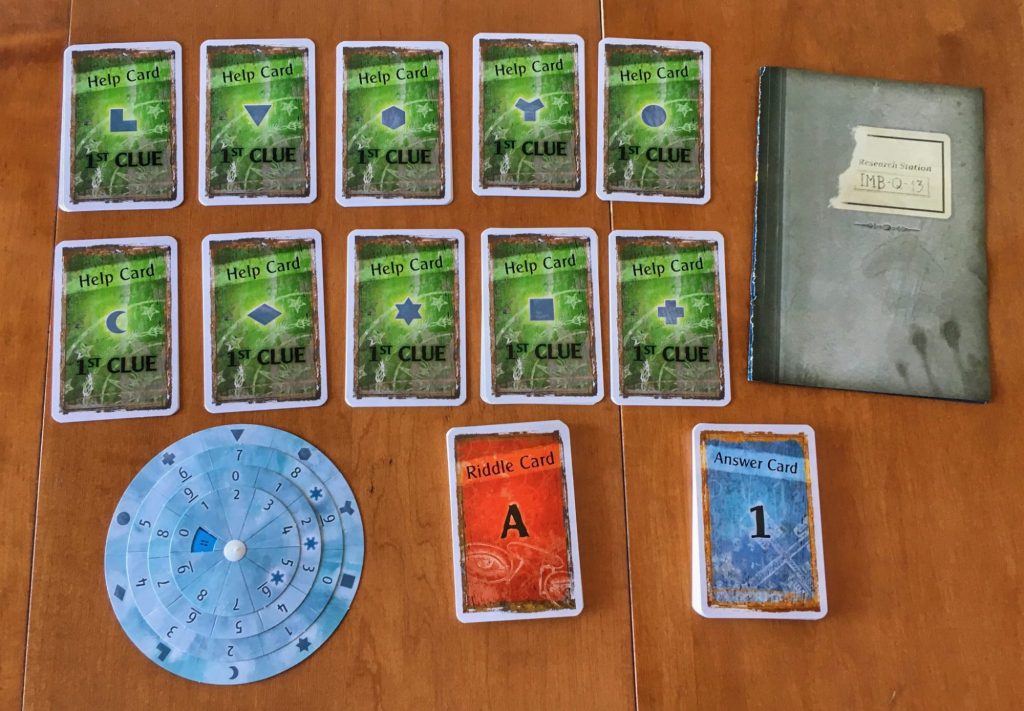
Course of Play
The goal of any Exit game is to escape (except for the Dead Man on the Orient Express scenario). To do this, you will search rooms and break into areas secured by locks with codes containing either 3 numbers or symbols, depending on the scenario.
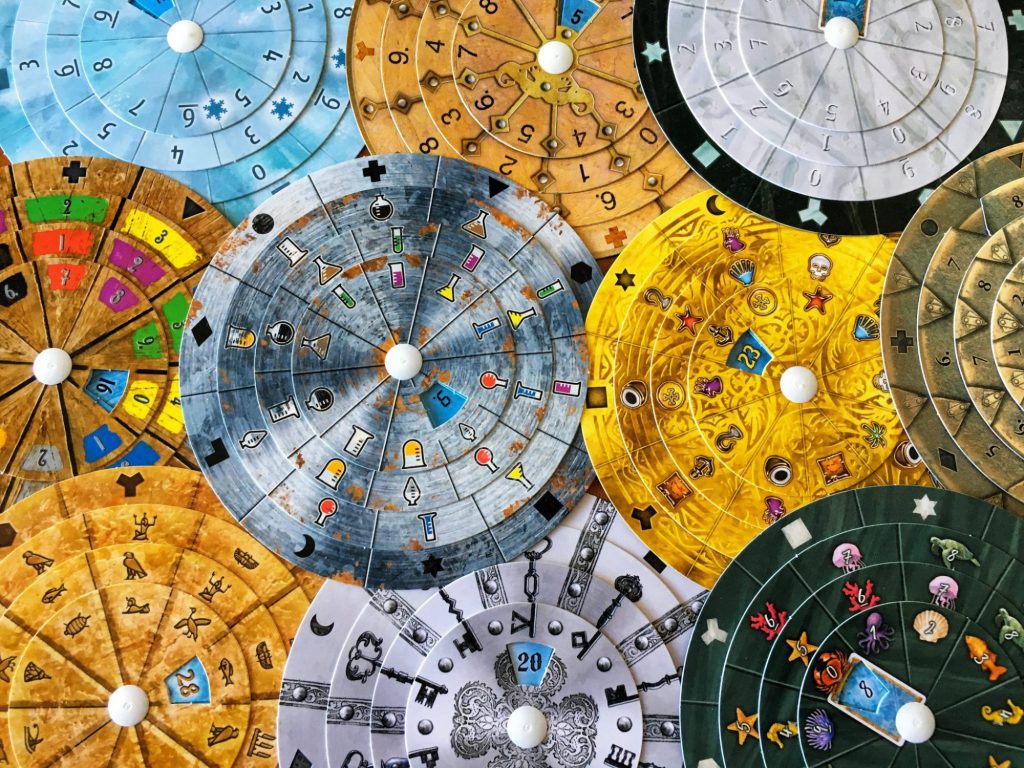
Along the edge of the Decoder Disk are symbols which stand for a lock or code to be cracked. If you find a puzzle with one of these symbols and you think you’ve cracked the code, enter it below the symbol on the Decoder Disk.

Once this is done a number will appear in the viewing window on the Disk’s smallest wheel. This tells you which blue Answer card you may look at. The Answer card will then show one of two things: an incorrect answer or a possibly correct one.
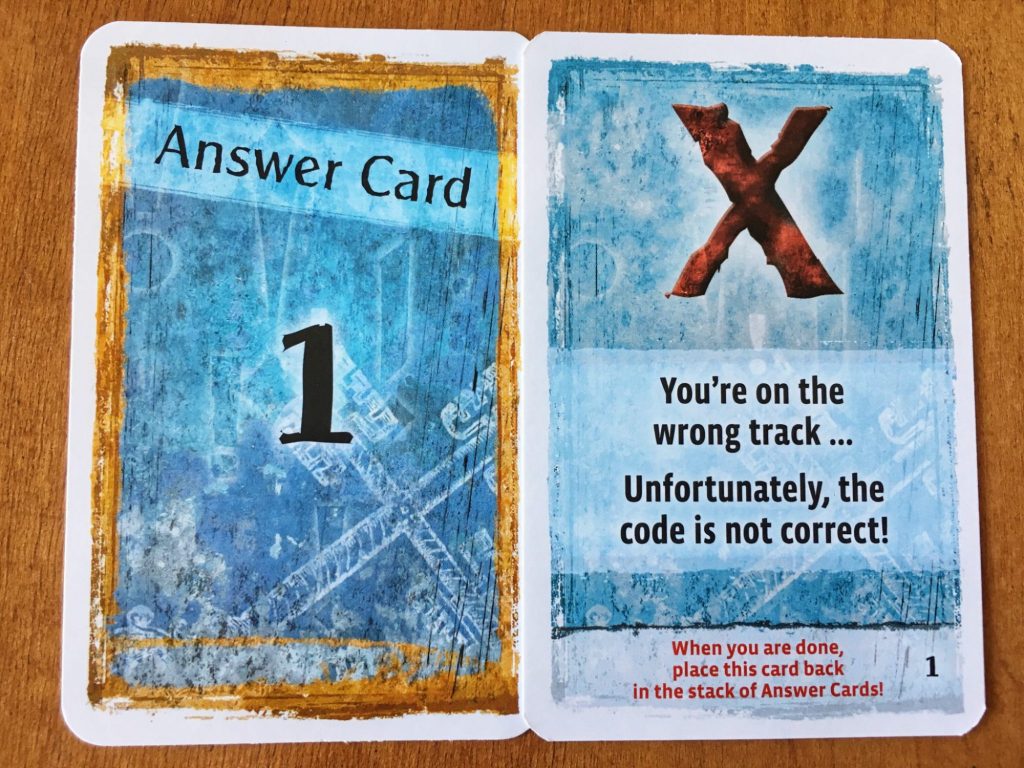

After you’ve drawn a possibly correct Answer card, find the object that is marked with the symbol for the code you’re trying to crack. Next, look at that object’s Answer card. If your code was really correct, the Answer card will tell you which new red Riddle cards you can draw from the stack to progress further in the game. The code is incorrect if you draw an incorrect Answer card (as pictured above). Play continues this way until all 10 codes have been cracked and you reach the end game Answer card which describes your escape.
Help!
At any point during gameplay, you’re allowed to take hints from Help cards. Each of the 10 codes will have their own stack of tiered Help cards. These cards are really useful because they can point you in the right direction if you’re stuck on a puzzle or if you are simply unsure about what to do next. They are also valuable because they can confirm what you already know. However, there is a catch: each Help card used will deduct stars from your final score unless they didn’t give you any new information.

The “1st Clue” will tell you which Riddle cards, objects, or Book pages you need, as well as a general hint how to use them. The “2nd Clue” gives a more detailed hint on how to use everything together. The “Solution” card explains exactly how the puzzle is solved and which code to enter on the Decoder Disk.
The App
Unlike other escape room board games, Exit: The Game does not require an app to play. However, the Kosmos Helper App is a good tool to use anyway because it provides a tutorial, a game timer with background music and effects, calculates your final score, and has bonus puzzles. The interactive tutorial is especially useful for those who want to save their brain power for the game itself rather than trying to learn the system. I would definitely recommend using it for your first play or two since it takes about the same time as reading the rulebook. Another bonus with the app: you can download content only for the scenario you’re playing which means you’re not wasting your precious hard drive space. More room for cat photos!


Which Exit to Choose?
When I first started playing the Exit games, my choice for scenarios were between hard, harder, and hardest. Now, with 10 different titles released in English, there is more variety for those looking to jump into Exit.
The Sunken Treasure, The Mysterious Museum, and The Abandoned Cabin
The Sunken Treasure and The Mysterious Museum have a difficulty rating of 2 out of 5 stars which makes them the perfect scenarios to introduce players to the Exit games. Each of these adventures are linear in nature: players solve each puzzle in sequence and are only given access to the Riddle cards and Book pages they need for that puzzle. Both scenarios hold your hand as you play through them, but that’s not to say they are easy. Even within the scenarios themselves, players will notice the puzzle difficulty increasing as they progress.

They are also the only two Exit titles recommended for children 10 and up (the others are 12+). For all other Exit games, I would recommend playing them with 1 or 2 other people because it’s important to have humans around who think differently and with which you can bounce ideas off. However, if you’re familiar with other escape room board games, you could probably play these scenarios solo like I did and still score pretty well.

The Abandoned Cabin has one of the most compelling Exit storylines and it still ranks among my favourites. The difficulty rating is only 2.5 out of 5, but players will notice many changes in the system from the previous 2 titles. The biggest change is that the scenario and its puzzles are no longer structured sequentially (which is also true for the more difficult Exit games). Players might be given Riddle cards or information to puzzles they have yet to find and they’ll have access to the scenario’s entire Book. Part of the game now is not only solving the puzzles and cracking codes, but also understanding how pieces of information work together.
The Forgotten Island, The Polar Station, The Sinister Mansion, and The Secret Lab
These Exit games have a difficulty rating of 3 out of 5, except for The Secret Lab which is rated 3.5. Overall they all work in the same way and you will notice that the puzzle and riddle difficulty increases slightly from the lower ranked scenarios.

Each scenario has a distinct theme and its own variety of puzzles, but for me, I liked what The Polar Station and The Sinister Mansion offered best. In terms of difficulty, I would say that The Forgotten Island is marginally easier and The Secret Lab is the most difficult, with the other two falling somewhere in the middle. Before playing any of these titles though, I would recommend trying, at least, The Abandoned Cabin. The first Exit game I ever played was The Secret Lab with 3 experienced friends. It took us over 3 hours to escape and we needed many Help cards (but we did also begin to play at 11pm). Needless to say, you can hopefully learn from my mistake.
Dead Man on the Orient Express, The Forbidden Castle, and The Pharaoh’s Tomb
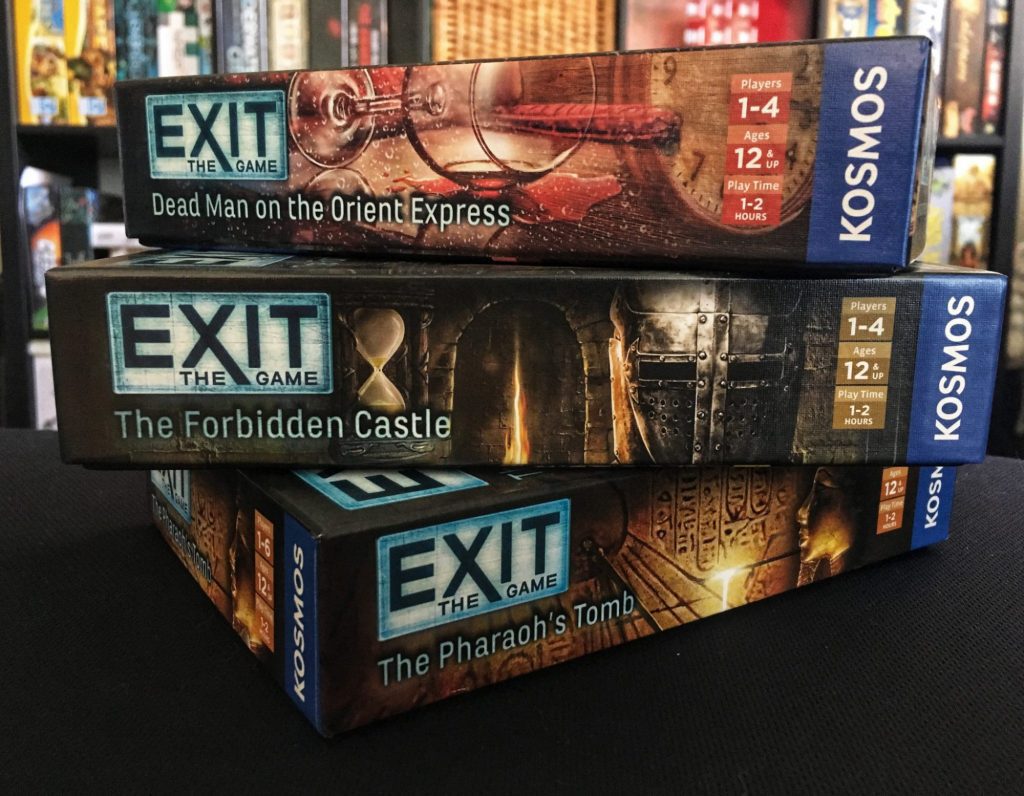
These 3 titles are the toughest Exit games on the market as they are rated 4 or 4.5 out of 5 in difficulty. The Pharaoh’s Tomb is, in my opinion, the most difficult scenario, preceded by The Forbidden Castle, and then Dead Man on the Orient Express. This last title, while the “easiest” of the 3, is my favourite Exit scenario to date because of its theme and unique puzzle implementation. In Dead Man on the Orient Express, you are trying to help a famous detective solve a murder aboard your train. In it, you will be assembling clues and solving puzzles to determine which of the 8 suspects committed the murder before the train reaches Constantinople. This was my favourite scenario because it really struck a chord with the puzzle-loving detective in me.

Before jumping into any of these 3 arduous Exit titles, I would highly recommend trying at least a few from the easier difficulties first. Dead Man, The Castle, and The Tomb all provide thematic, challenging experiences, but they can also be incredibly frustrating if you don’t have any experience with the Exit system.
Final Thoughts
I love Exit: The Game and of all the escape room board games (Unlock!, Deckscape, The Enigma Emporium, etc…), Exit is by far my favourite. There are very few instances where I will purchase all the released content for a game, but Exit is one of them (the only other is Ticket to Ride).
There are so many things I like about how the Exit system works, and the way it all comes together is what sets it apart for me. First, I really like the tiered hint system and how you aren’t penalized for taking a hint which gives you information that you already know. I also like that you are given both the answer AND an explanation for it on the “Solution” card. It’s astounding to me how many escape room games don’t provide the players with an explanation. The only thing more frustrating than being stuck on a puzzle is not understanding how you could have possibly gotten the answer for it.
Second, I enjoy the style of riddles and puzzles in the Exit games. Overall I find them to be much more logical and challenging than some other systems which focus on more practical, real-world puzzles and solutions. Sure, the super logical puzzles are sometimes a stretch thematically, but I’m usually looking for an escape room game that is more challenging than it is thematic.
The possibly correct Answer cards are another reason why I prefer Exit: The Game. Many (many) times I have stumbled upon a correct answer in other escape games without having had all the necessary clues. This is virtually eliminated with the Exit answer system because if you don’t have all the clues, you won’t get it right. There even was a time when I had all the clues and the right answer, but we kept choosing the wrong object and getting an incorrect Answer card. (This may or may not have lead me to disassemble the Decoder Disk during gameplay…)

The final reason why I love the Exit games so much is that they always surprise me and keep me guessing. I’ve now played almost every escape room board game on the market so I’ve become familiar with the different types of riddles used and the style of puzzles. Yet, there is always at least one riddle in an Exit game that completely blows my mind and impresses me. They aren’t even necessarily the most challenging ones, but Inka and Markus Brand always manage to astonish me with their innovative and clever implementations of ideas. It is primarily for this reason that I think Exit: The Game is simply the best and definitely worth checking out.
Author’s Update
Since this mega review was written, KOSMOS has continued to put out different scenarios in the Exit: The Game line and below you will find brief descriptions of each.
2019 releases
In 2019, three new scenarios were published: The Haunted Roller Coaster, The House of Riddles, and the first “big box” version, The Catacombs of Horror. If you’d like, check out the separate, more detailed review I’ve written about these three games. Otherwise, here is a brief description of what these scenarios entail.

The Haunted Roller Coaster: This scenario is rated a 2 out of 5 star difficulty and it follows the same structure as the other two previously released with the same difficulty level. The Haunted Roller Coaster is linear so players are tasked with solving one puzzle at a time and the puzzles get progressively more difficult. While this scenario had some great puzzles and was not nearly as scary as it seemed to be initially, I wouldn’t recommend it as a beginner’s introduction to Exit: The Game simply because there was a lot of hidden information that I think experienced players familiar with the system would know to look for and inexperienced players might struggle with.
The House of Riddles: This scenario is also a 2 out of 5 star difficulty and follows the same structure as The Haunted Roller Coaster. There are some great puzzles in The House of Riddles, including one that makes use of your body and the physical space in which you’re playing. I would highly recommend The House of Riddles for any beginner looking to jump into Exit: The Game; it features a good mix of puzzles and doesn’t ask players to look for too much hidden information.
The Catacombs of Horror: This game is huge…well relatively speaking; I like to call it the “big box” version of Exit: The Game because it’s more than double the original Exit box size and it includes a longer, two-part escape room experience. At the time of its release, it is also the most difficult Exit game you could play. Every component in the box is saturated with information that might be required to solve the next puzzle — or be used four puzzles later. It can be a lot. Yet, the gameplay is satisfying and you feel wonderful when things line up and you finally understand what you’re being asked to do. Experienced Exit players will find The Catacombs of Horror a welcome challenge; if you’re new to Exit or escape rooms in general, I’d suggest leaving this one until after you’ve dabbled in some of the less difficult scenarios. You will appreciate the immersive gameplay experience and puzzles in The Catacombs of Horror a lot more if you do.


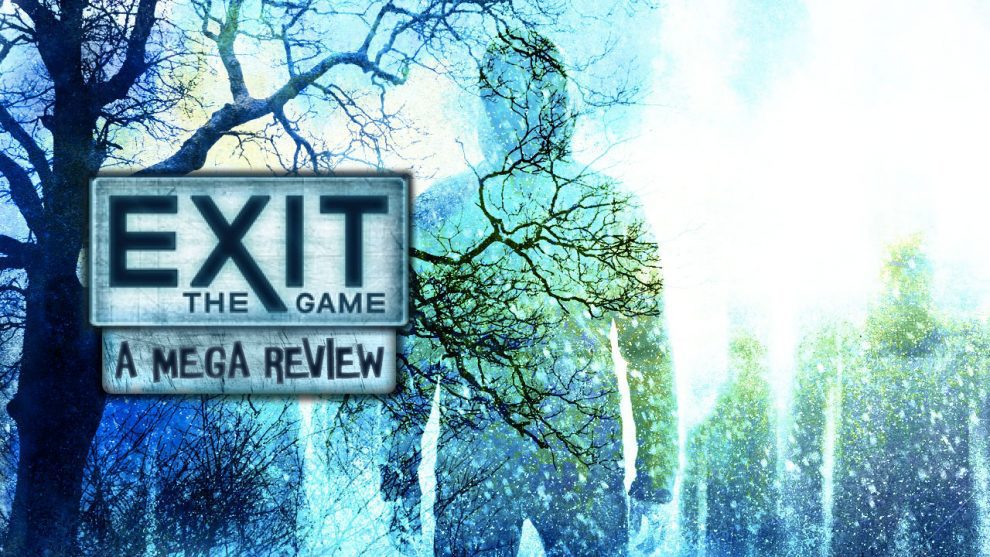



















Any idea when the next Exit game will be available? I have played them all already. They are the best!
Have you played the Exit games just released that are not included in this review (The Haunted Roller Coaster, House of Riddles, or The Catacombs of Horror)? If not, they are worth checking out. Haunted Roller Coaster and House of Riddles are on the easier side, but Catacombs of Horror is quite difficult.
Also it looks like there are 3 new Exits that released in German and, in the past, they’ve usually been translated and brought to the English market around Origins (May/June).
Thanks for the write-up! Just placed an order for the Abandoned Cabin and Sinister Mansion, can’t wait to play them 😀
Thanks for the mega review, great help for beginners!
Thank you for your review. My fiance and I are doing a remote social distancing get-away for our honeymoon next week and your review has helped me in selecting a few of these escape rooms for activities we can do safely which will also help us bond. She loves puzzles.
Your review is thorough without giving any spoilers. Thank you again!
Thanks for your kind words KC, we’re glad to help. Have a wonderful time on your honeymoon!
Thank you for reading and for your kind words, KC! Congratulations and have a great time playing Exit: The Game on your honeymoon : )
Great reviews. Helped me to make some choices as a beginner.
Hi. I’ve found your reviews about escape games very useful to get an idea of all of them with its pros & cons. Thx.
I’ve seen in your review about the exit series that Player count : 1 – 6 . But i’ve seen other web pages and states 1-4. What is your opinion about playing 6 in exit series? or the title fits better to 6? may be unlock games are best suited for playing 6?
thx
Hello! Thank you for your kind words and I’m glad the reviews have been able to help you get a better idea of what the different escape room board games have to offer.
When the Exit games were first released, they had a player count of 1-6 on the game box and on BGG. Our site uses this information which is why you are seeing the “1-6” listed on the player count here. However, since the initial release of the first 3 Exit games, the player count has changed to 1-4 (this includes the new editions of the first 3 Exits, as well as any subsequent Exit release to date).
As much as I love Exit: The Game, I wouldn’t recommend it for 6 players…and I even have a hard time recommending it for 4. With the way the game and its puzzles work, it becomes a struggle with larger groups no matter which title you play (in my experience). For me, I find the same thing has been true for the Unlock games I’ve played (but I should note I haven’t had a chance to play the 3 most recent releases so perhaps they work better). I just find that with these games and larger groups, you almost have to fight to be able to see the various cards, items, and information.
As for escape room games you *could* try with a larger group, Deckscape works fantastically. I go into detail in my review but essentially the deck of cards gets divided up early in the game, giving players the option to break off into small groups and work on the puzzles in a stack of cards. (https://www.meeplemountain.com/reviews/deckscape-mega-review-small-box-big-experience/ in case you wanted to check it out.)
Hope this helps!
Sure. It helped a lot. You’re a teacher and your explanations are like an open book. 10 out of ten Thx for your answer
Thanks for writing this review, it’s been helpful before we buy. Could you tell me, is the game easily reset? We’ve been playing Professor Puzzle which is really easy to reset so that we can send to other family members for them to enjoy but I’ve heard that Exit involves destroying pieces of the game. Thank you!
Thanks for reading, Elizabeth. Unfortunately no, the Exit games cannot be reset as every one of them involves some kind of component destruction. Personally I don’t mind this because it means that the designers are able to create puzzles that use physical space in some interesting ways, but it does mean that once you’ve played it, that’s it. (I have heard of people photocopying the components that are meant to be destroyed, but this isn’t something I’ve tried myself.)
There are, however, other escape room board games that pack a good puzzle-solving punch with a similar price point to Exit, but they are instead easily reset and don’t involve component destruction. (Conveniently, I’ve played and written about most of them.)
Unlock!: https://www.meeplemountain.com/reviews/unlock-escape-adventures-review-now-with-fewer-padlocks/
Note the newer sets, which I have yet to review, include 3 different scenarios in one box so the price is a little higher.
Deckscape: https://www.meeplemountain.com/reviews/deckscape-mega-review-small-box-big-experience/
Escape Room: The Game I and II: https://www.meeplemountain.com/reviews/escape-room-the-game-escape-rooms-ii-review-spying-in-a-space-station-flashing-those-pearly-whites/
Note there is some component destruction in these games, but whatever is meant to be destroyed has a printer symbol on it. Anything with such a symbol can be downloaded from the publisher’s website and printed. (I did this myself when I played and then reset the game with the original components and easily passed it along to someone else.)
Hope this information helps!
This is an awesome review. Thank you so much for making me feel better about one of the Exit games taking three hours plus to finish. A lot of people say that they do it in an hour and I’m just left gob snacked. We just did Dead Man on the Orient Express and really enjoyed that one for the subplot of solving the murder. I’m looking forward to reading your reviews going forward before we purchase more games. That said I have a stack of nine in front of me waiting to be played! Needless to say I really love these Exit games.
As for anybody who’s questioning how many players. I’m totally in agreement with you that two is the ideal number. There’s enough brain power to solve the problems and, as you say, someone to share the excitement with when you crack a particularly difficult puzzle. The more people, at some point, just makes it more difficult to see the riddle cards and the book and really solve the problem – I think it would be more frustrating than fun at some point.